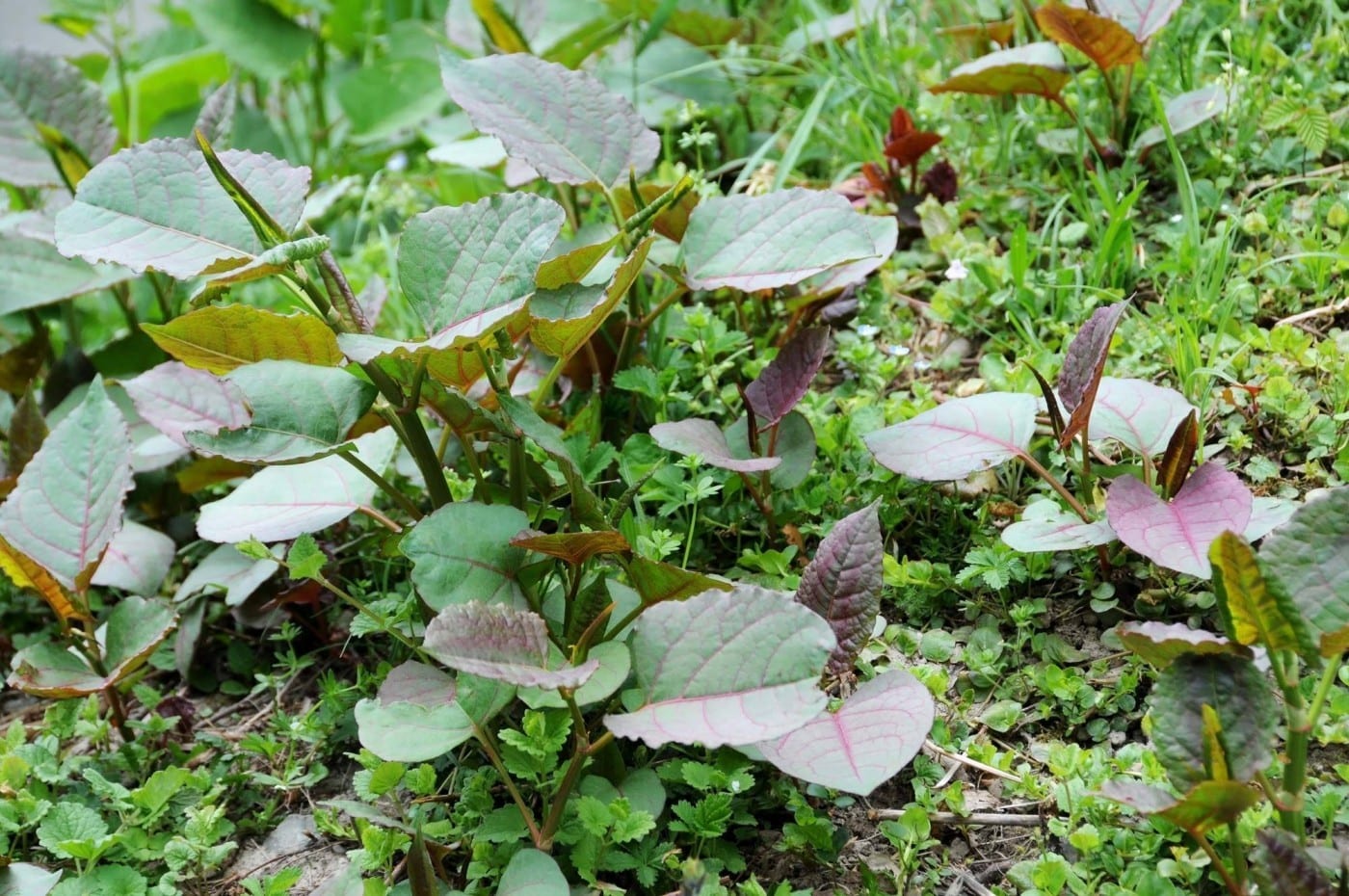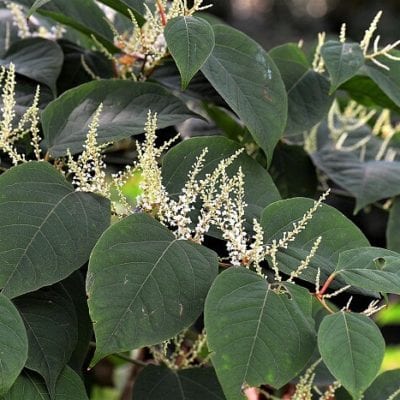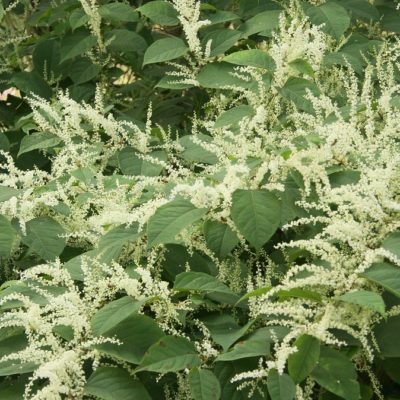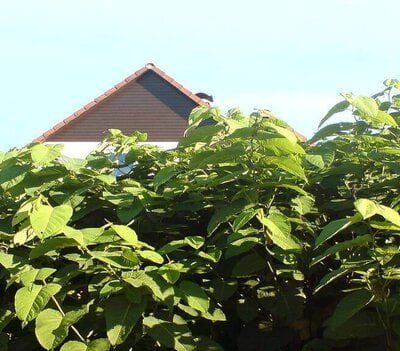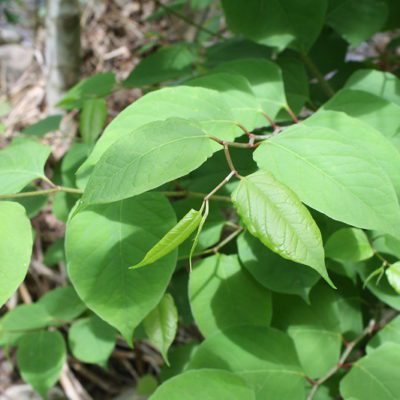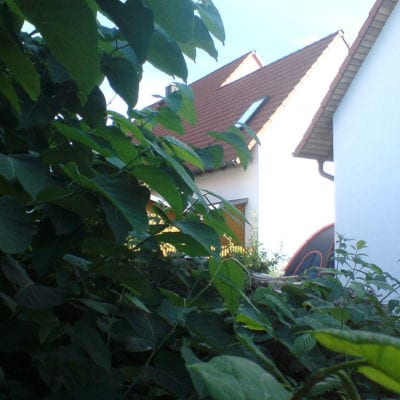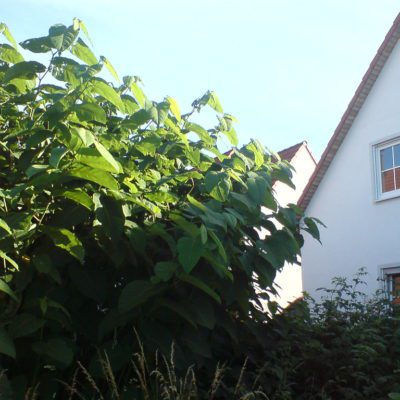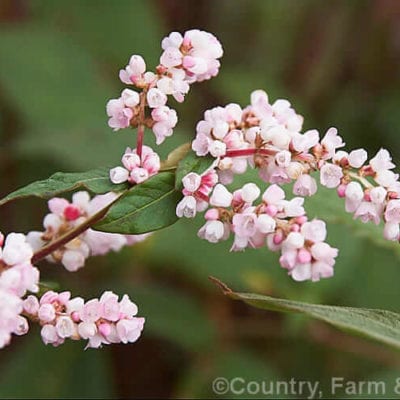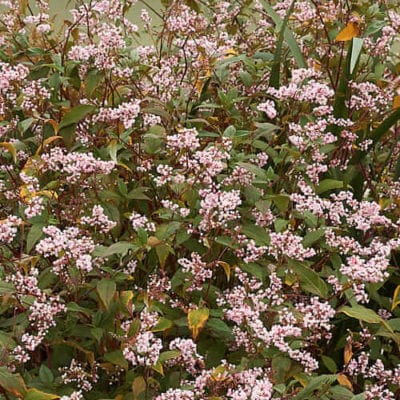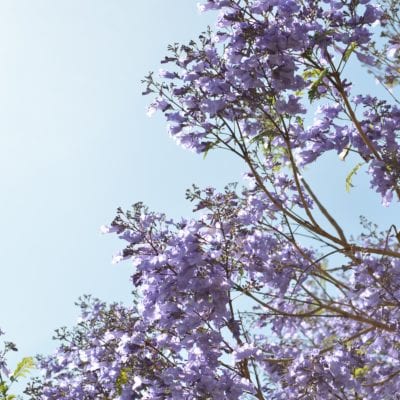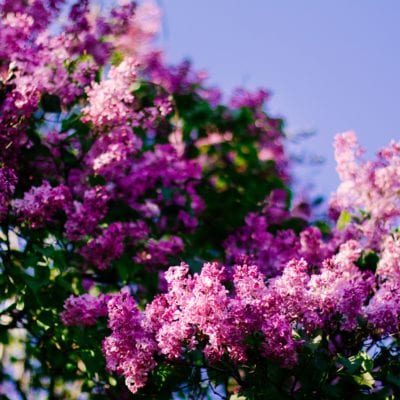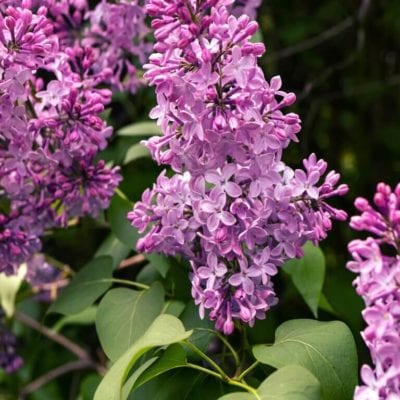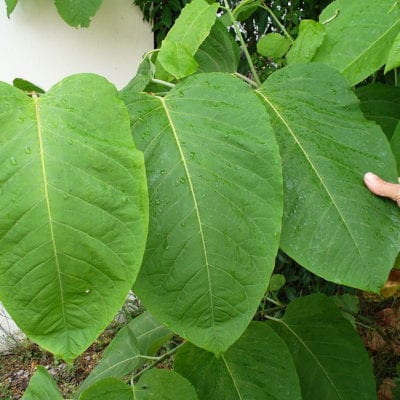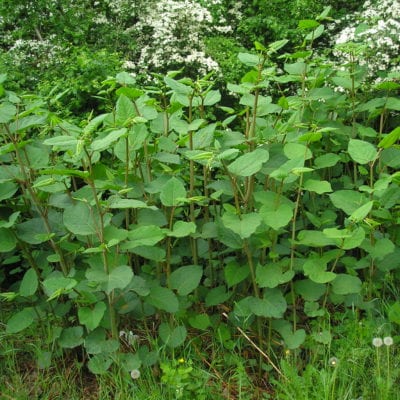Japanese Knotweed Identification – A Complete Guide
Japanese Knotweed is one of Britain’s most perennial and pernicious weeds. It’s known for its outstanding ability to spread quickly throughout Britain. Infamous for its potential to cause costly damage to property, Japanese knotweed is the most widespread form of knotweed in the UK. Typically blooming between late summer and early autumn, Japanese knotweed flowers are a distinct creamy white colour and form in clusters of up to 10cm long. Dying back around October, the flowers leave behind hollow stems throughout the winter months.
On this page, we’ll look at how to identify Japanese knotweed, characteristics of Japanese knotweed, different types of Japanese knotweed, plants that look like Japanese knotweed and many other Japanese knotweed related topics and subtopics.
Use our identification form at the side of this page if you’d like to use our free Japanese knotweed identification service. Or, check out our Japanese knotweed picture gallery if you’d like to know more about how the plant looks.
See our reviews page to learn about some of the Japanese knotweed-related cases we’ve helped win.
Contents
How to Identify Japanese Knotweed
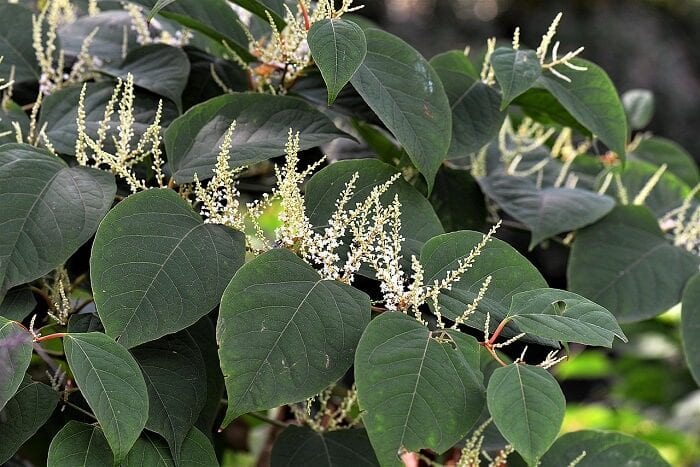
Japanese knotweed blooms between late spring and early summer
Frequently mistaken for common shrubs such as dogwood due to the large amounts of foliage it produces, Japanese Knotweed is identified by its creamy white flowers, bamboo-like stems and shovel-shaped green leaves. Below we’ve created a detailed overview of Japanese Knotweed characteristics.
Japanese Knotweed Characteristics
- Japanese Knotweed Flowers – Cream white in colour, 0.5cm wide, forms clustered panicles that can grow to 10cm. Blooms very late summer (August/September)
- Japanese Knotweed Height – Typically grows to 2.1m (7ft) but can grow up to 3m (9.8ft).
- Japanese Knotweed Leaves – Light green with red or purple flecks. Heart or shovel-shaped with a pointed tip and shoot out from nodes in a zig-zag pattern. New Japanese Knotweed leaves are rolled up with dark red veins while mature leaves can grow up to 20cm.
- Japanese Knotweed Stem – Grow in a zig-zag pattern, green with purple and red speckles, hollow and grows to 2-3 metres in height. Can Grow up to 2cm a day.
- Japanese Knotweed Roots (Rhizomes) – Outside is dark brown, inside is orange/yellow. Can grow 3 metres deep and between 2 to 7 metres horizontally, depending on soil and weather conditions. The diameter is approximately 20cm.
- Japanese Knotweed Growth Rate – Can grow up to 10cm per day during late spring / early summer.
- Japanese Knotweed Seeds – Heart-shaped and feature small wings. Extremely rare for seeds to germinate. New plants grow from nodes or pieces of green stem in soil or water.
- Japanese Knotweed Species – Reynoutria japonica from the Polygonaceae family.
- Japanese Knotweed Order – Caryophyllales
- Japanese Knotweed Origin – Native to Japan, China and parts of Korea and Taiwan.
Japanese knotweed is a hotly debated topic in Parliament [1], within the property industry and in the courts, however, positive identification of the plant is required before any legal action is started. Although the plant has a few defining features (broad green, shield-shaped leaves and bamboo-like stems), Japanese knotweed takes on different forms throughout the seasons. Therefore, if you know what you’re looking for, it’s possible to discover an infestation at any point in the year.
This guide is intended to point property owners in the right direction when it comes to identifying this invasive plant and takes into account how knotweed appears throughout the year, other plants that it’s often mistaken for and what risk factors are related to an infestation.
Struggling to identify your potential Japanese Knotweed infestation?
At Knotweed Help, we provide a free Japanese Knotweed identification service. Send us images of your potential infestation via our identification form and one of our Japanese Knotweed experts will be in touch with you soon to help you identify your infestation.
Free Japanese Knotweed identification service
Upload your photoWhat Does Japanese Knotweed Look Like?
Japanese Knotweed Flowers
Japanese Knotweed can be identified by its creamy-white coloured flowers (panicles) that bloom as clusters between late August and mid-September [12]. Japanese Knotweed flowers grow up to 10cm long and 0.5cm wide alongside the leaf foliage, creating a dense appearance that often blocks the distinctive stems from view. A flowering Japanese knotweed plant is a sign that it is well established and could therefore be a challenge to remove. Identifying and treating the plant before it reaches the flowering stage in late summer can prevent a longer-term infestation.
- Japanese knotweed blooms between late spring and early summer.
- Japanese knotweed flowers – “Japanischer Staudenknöterich (Fallopia japonica)” by blumenbiene is licensed under CC BY 2.0
Japanese Knotweed Shoots
Japanese Knotweed shoots look similar to canes, and grow in clearly defined segments with a hollow centre. Some key features to look out for when identifying Japanese Knotweed shoots are:
- They grow up to 2-3 metres in height
- Inside of the stem is hollow
- Coloured red in Spring
- Coloured green in Summer
- Similar appearance to Bamboo shoots
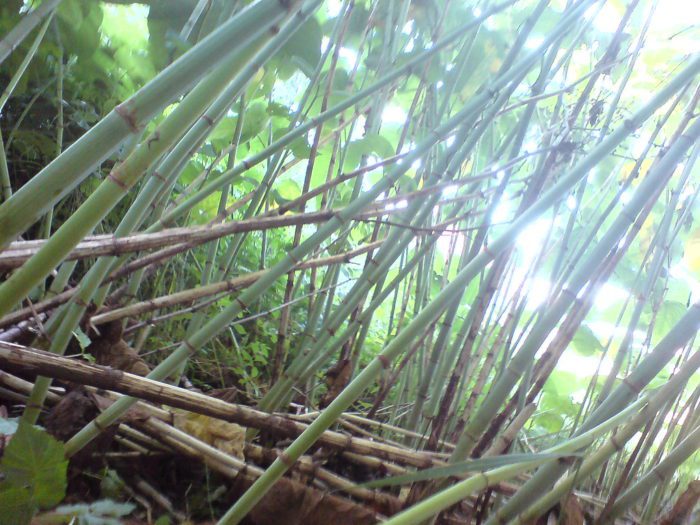
Japanese knotweed shoots – “japanese knotweed” by dankogreen is licensed under CC BY 2.0
Leaves
When the plant is in foliage, Japanese knotweed leaves are bright green and feature a signature shield or heart-shaped leaf. Each leaf has a pointed end and is arranged at staggered intervals along the stem. Leaves can be up to 14cm long, but don’t expect to see any during the winter, as the plant’s green foliage doesn’t last through the colder months.
Knotweed leaves are designed to deliver energy to the plant’s rhizome system and encourage more growth at a later time. Some of the main characteristics of Knotweed leaves to look out for are:
- Heart shaped with a pointed tip
- Zig-zag growth pattern
- Lush green colour
- Grow up to 20cm long
- Japanese Knotweed Leaves – “japanese knotweed” by dankogreen is licensed under CC BY 2.0
- Japanese knotweed leaves
Species
Japanese knotweed (Reynoutria japonica/Fallopia japonica) is the most common species of the plant found in the UK [3], however, it has been known to hybridise with related species. Giant knotweed (Fallopia sachalinensis/Reynoutria sachalinensis) is found widespread throughout the UK but is not as common as Japanese knotweed [4]. Fallopia japonica var. ‘Compacta’ is the dwarf variety of the plant, that is much smaller in stature.
Fallopia x bohemica or Reynoutria x bohemica is the result of a hybridisation between Fallopia japonica and Fallopia sachalinensis, it tends to grow larger than Japanese knotweed [5]. Hybridisation has also occurred between the closely related Russian Vine (Fallopia baldschuanica), its common name is railway-yard knotweed.
Height
Japanese knotweed can typically be identified during early summer by its hollow stems that feature purple speckles and are up to 3 metres in height. The less frequently occurring Giant knotweed can grow up to 5 metres in height, whereas the hybrid Fallopia x bohemica has been known to grow up to 4 metres. Dwarf knotweed does not typically exceed 1 metre in height.
- Japanese knotweed height – “japanese knotweed” by dankogreen is licensed under CC BY 2.0
- Japanese knotweed next to a building – “japanese knotweed” by dankogreen is licensed under CC BY 2.0
Seeds
Japanese knotweed has heart-shaped seeds that feature small wings. New growth from seeds is very rare [6], as only the female of the species was imported into the UK. For the most part, Japanese knotweed has been spread throughout the country by the transportation or fragmentation of its rhizomes. The rhizomes are effectively the plant’s root systems, with a fragment of the rhizome capable of generating an entirely new plant if given the proper conditions. Unfortunately, Japanese knotweed has been observed to hybridise with other related species [7] which has led to new plants that are able to then spread by seed down the line.
Japanese Knotweed Throughout the Year
There are four main different types of Japanese Knotweed. These are: Giant Knotweed (Reynoutria sachalinensis, formally Fallopia sachalinensis), Himalayan Knotweed (Persicaria Wallichii), Dwarf Japanese Knotweed (Reynoutria Japonica var. ‘Compacta’, formally Fallopia Japonica var.
Free Japanese Knotweed identification service
Upload your photoJapanese Knotweed in Spring
Japanese Knotweed grows fastest during Spring and begins to spring new shoots, making them a lot easier to spot. When identifying Japanese Knotweed in Spring, there are some features that you can look out for:
- New shoots emerge as red/purple asparagus-like spears
- Leaves are dark green or red and rolled up
- Canes reach up to 3 meters in height
- Shoots have right red/pink tips – can grow up to 1-3cm wide
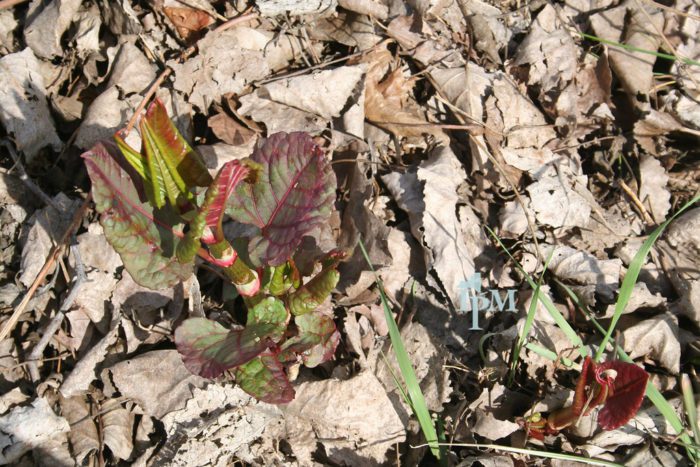
“Japanese knotweed spring shoots” by The NYSIPM Image Gallery is licensed under CC BY 2.0
Once spring is well and truly underway, shoots take on a greener hue and become easier to spot due to their accelerated growth [8]. Now growing as spear-shaped shoots, sometimes described as ‘asparagus-like, the leaves are red and rolled up, but they soon turn green as the plant grows skyward.
Knotweed in June
Japanese knotweed becomes easier to spot in June, as this is when the plant is most visible above ground. Knotweed growth accelerates significantly starting in June and throughout the rest of summer, making the plant much more conspicuous. Its spade-like pointed leaves are bright green during this month.
Japanese Knotweed hollow shoots can grow up to 2cm a day in June, the leaves are most easily recognised by their shield shape with an alternating stem pattern. This presents a good opportunity to treat the problem with a PCA-accredited glyphosate programme [9], professionals are able to assess an infestation and inject each plant with their specialist equipment.
Related: How To Get Rid Of Japanese Knotweed
By mid-summer knotweed plants are close to reaching their full height (between 1.9-3m). The shoots are now less green and are rigid with more pronounced dark purple speckles. Clear nodes are visible on these shoots giving them the appearance of bamboo, they can also be snapped easily in the hand. It’s not until late summer that Japanese knotweed flowers; multiple bunches of creamy white flowers appear amidst the leaves, but the seeds that are produced from this process rarely lead to new growths.
Japanese Knotweed in Summer
In the summer, Japanese knotweed goes through an exponential growth period with average heights of 2-3 meters being achieved by some plants at their peak. It can also form dense clumps of foliage at this time of year, making it easier to identify during the mid-Summer months.
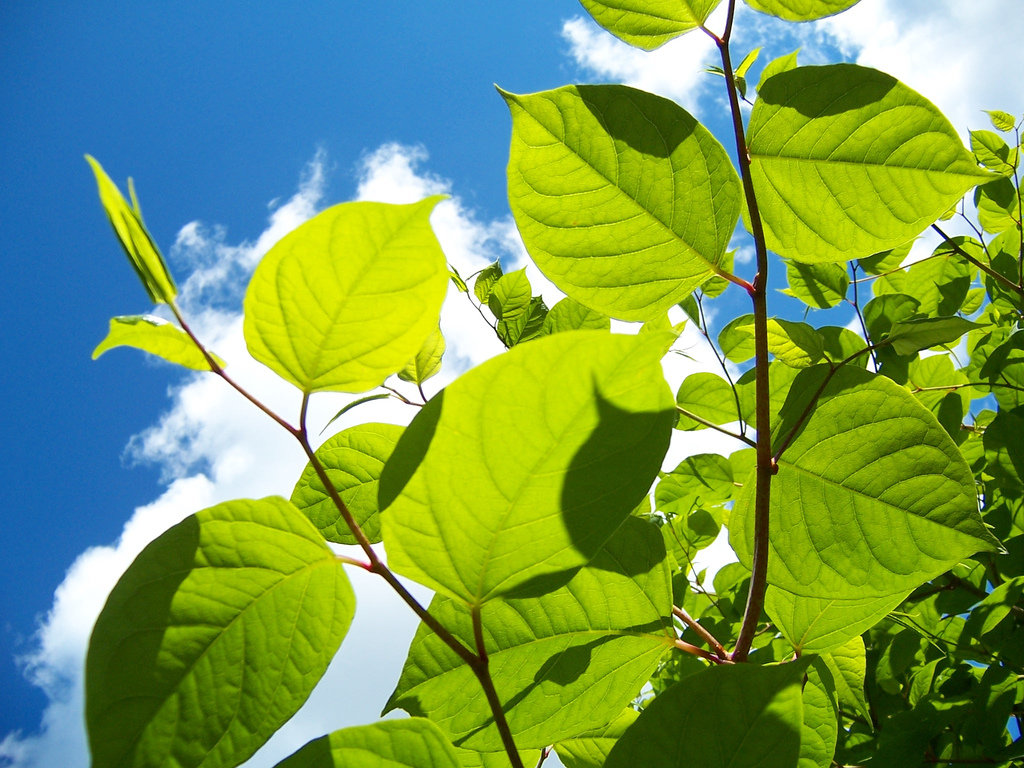
Japanese knotweed leaves in summer are bright green and spade shaped – “Japanese knotweed 2” by cheesechoker is licensed under CC BY 2.0
Japanese Knotweed in Autumn
As autumn progresses, the characteristically bright green leaves turn a vivid yellow and the plant sheds seed cases. If the weed is left to its own devices the leaves and flowers will eventually begin to fade and fall back. Leaves fall off the shoots which start turning brown and then a pale straw colour as winter progresses, also taking on a more rigid, woody form.
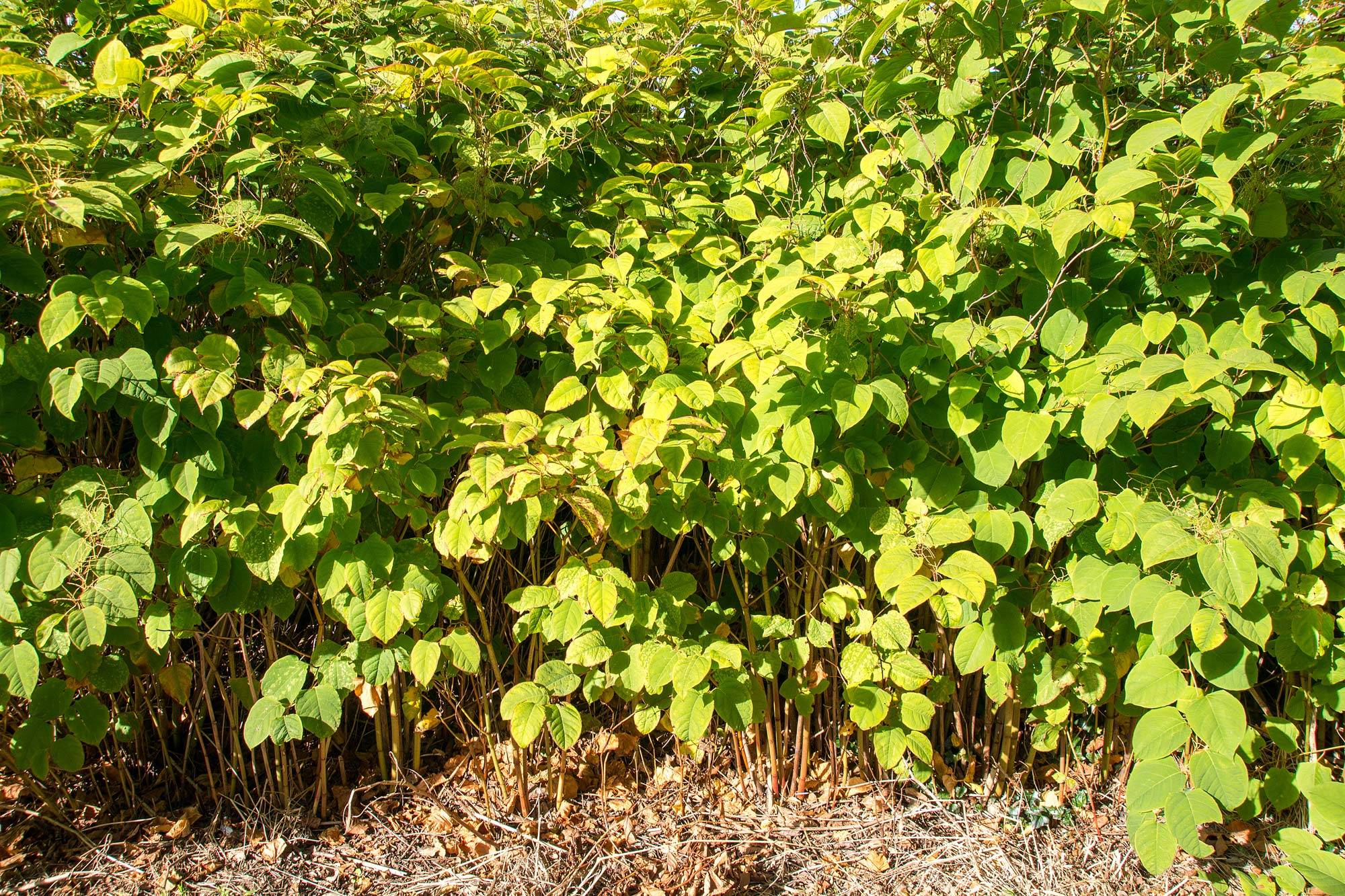
Japanese Knotweed leaves turn yellow in Autumn
Japanese Knotweed in Winter
Knotweed appears to ‘die back’ during winter, but it’s unwise to assume that the problem is simply gone. In the middle of winter, all that remains above ground is a collection of pale, dry canes with the Japanese knotweed dormant beneath the surface waiting for warm weather to sprout and spread further. Whilst the plant enters this dormant phase it is still very much alive.
Free Japanese Knotweed identification service
Upload your photoKnotweed Roots and Shoots
Japanese Knotweed Roots
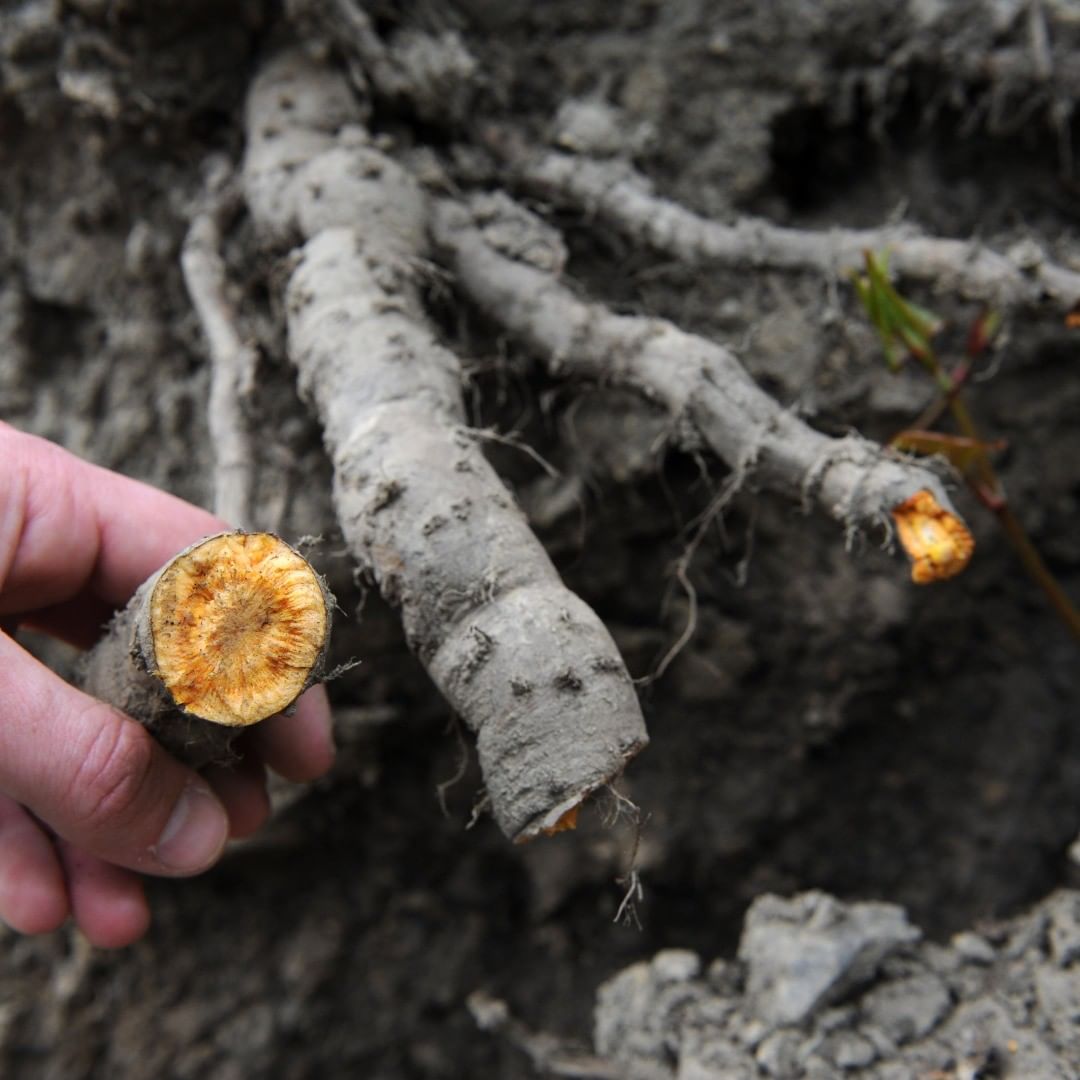
Japanese knotweed rhizome roots. Copyright, reproduced with kind permission from Environet.
Japanese knotweed has a robust root system that is comprised of a network of rhizomes. These tough, woody roots can be collected together in large crowns which can be difficult to remove from the ground without the help of machinery. When identifying Japanese Knotweed Roots, look out for:
- Dark brown colouring on the outside
- Orange colouring inside
- Easily breakable
- Burrow up to 3 metres deep into the ground
Rhizome root systems can burrow up to 3 metres deep into the ground with individual rhizomes growing up to 20cm thick, but this kind of growth only occurs if the plant is given the time and space to flourish. The veracity of this plant can make matters particularly difficult in disputes involving neighbours. Japanese knotweed spreads easily underground during the winter via its root system without even the most attentive of gardeners noticing. Only in the spring, when shoots begin to emerge, would the knotweed problem be visible above ground.
Japanese Knotweed Shoots
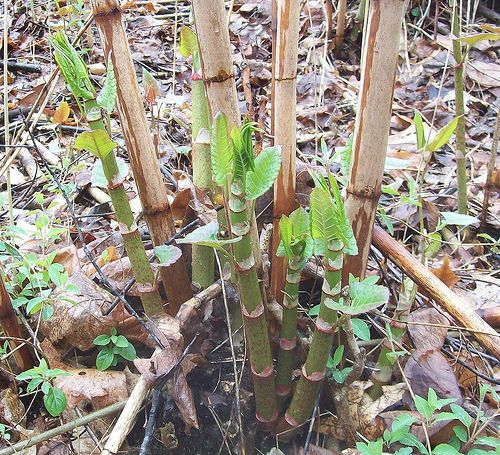
Young Japanese knotweed shoots growing amongst old canes
Japanese knotweed shoots grow up to 2-3 metres high, are hollow and have purple speckles. Knotweed shoots are often mistaken for being bamboo [15], as they have a similar node-based construction and are hollow on the inside. They start life as a pink or red shoot that is not dissimilar to asparagus in appearance, these are edible at this point and have become popular with foragers in the UK. Once the plant grows it takes on a greenish hue, before developing a darker, muddier shade and purple speckles when it reaches maturity. At its mature height of 2-3 metres, it is no longer edible, and each stem can be snapped easily in the hand. During autumn these shoots start to turn brown, before becoming even more brittle and pale in winter.
Japanese Knotweed Identification Video Guide
Plants mistaken for Japanese Knotweed
The following plants share look like Japanese knotweed but have a few crucial differences which may help you confirm or rule out a positive identification of the plant:
-
- Lesser Knotweed (Persicaria campanulata)
- Lilac and Woody Shrubs & Tress
- Giant Knotweed (Fallopia sachalinensis)
- Dwarf Knotweed (Fallopia japonica var. compacta)
- Fallopia x bohemica
- Railway-yard Knotweed (Fallopia x Conollyana)
- Russian Vine (Fallopia baldschuanica)
- Bindweed (Calystegia sepium)
- Dogwood (Cornus) and woody shrubs and Trees
- Heart-leaved houttuynia (Houttuynia cordata)
- Red Bistorts (Persicaria amplexicaulis)
- Himalayan Balsam (Impatiens glandulifera)
- Broadleaved Dock (Rumex obtusifolius)
- Bamboo
- Himalayan Honeysuckle (Leycesteria formosa)
- Horsetail (Equisetum arvense)
- Buckwheat (Fagopyrum esculentum)
Lesser Knotweed (Persicaria campanulata)
- Lesser Knotweed’s flowers are almost identical to Japanese Knotweed panicles
- Lesser Knotweed’s heart shaped leaves are very similar to Japanese Knotweed’s leaves
Referred to by some as Polygonum polystachyum, Lesser Knotweed is frequently mistaken for Japanese knotweed. This is due to its similar bamboo-like hollow stems, small flower clusters and similar height. Native to the Himalayas, Lesser Knotweed is one of the least common knotweeds in the UK and differs from Japanese knotweed in its long thin ovate leaves, and pink flowers.
Lilac
- Lilacs green long stems are sometimes misinterpreted as Japanese Knotweed stems
- From afar, lilac flowers can be mistaken for Japanese knotweed panicle flower clusters.
- Lilac leaves are often mistaken for Japanese Knotweed leaves
Similarly featuring green spade-shaped leaves, Lilac is commonly mistaken for Japanese Knotweed. Unlike Japanese knotweed, Lilac leaves grow opposite each other along woody stems. However, Lilac’s vibrant iridescent flowers – blooming in early spring – provide the clearest visual difference from Japanese knotweed.
Giant Knotweed (Fallopia sachalinensis)
- Giant Knotweed (Fallopia sachalinensis) leaves are similarly heart-shaped, but are much bigger and have less pointed tips than Japanese knotweed leaves. Picture by Molekuel licensed under CC-BY-SA-2.5
Growing up to 5 metres in height, Giant knotweed (Reynoutria sachalinensis, formally Fallopia sachalinensis) is one of several different types of Japanese Knotweed [16]. Other different types of Japanese Knotweed include dwarf Japanese Knotweed (Reynoutria Japonica var. ‘Compacta’, formally Fallopia Japonica var. and Himalayan Knotweed (Persicaria Wallichii).
Whilst Giant Knotweed plant is found throughout the UK, it’s not as commonly found as its smaller relatives. The plant was imported to the UK around the same time in the 19th century as a curiosity for Victorian horticulturists who were impressed by the speed of which this plant could grow. Similar to Japanese knotweed, it has spread mostly through the dispersion of its rhizomes as opposed to typical reproduction methods.
Dwarf Knotweed (Fallopia japonica var. compacta)
Considered to be much less invasive than Japanese knotweed, the dwarf variant grows to 1 metre tall at most and retains much of its larger relatives’ physical traits. The plants’ stems grow in nodes and stems are produced in a zig-zag pattern. The leaves are noticeably different, however, having a darker green hue and leathery appearance [17]. The edges of the leaves are crinkles and feature reddish veins which can make it easier to distinguish from the lush green leaves of the more common species.
Fallopia x bohemica
- Reynoutrica x bohemica Japanese knotweed hyrbid. By Julia Kruse licensed under CC BY-SA 3.0
Also known as Reynoutria x bohemica, this plant is a result of the hybridisation between Japanese knotweed and Giant knotweed [18]. The plant grows in a similar fashion to Japanese knotweed however the leaves grow much longer than its relatives. Both sexes of the plant are found within the UK, with hermaphrodite plants outnumbering sterile-male plants, however the plant still mostly spreads through dispersal of rhizomes. Fallopia x bohemica is often underreported and is invasive throughout mainland Europe and in some states of America.
Railway-yard knotweed (Fallopia x conollyana)
First discovered in Wales in 1983, this hybrid plant has been reported to be a cross between Fallopia japonica and F. baldschuanica [19], having been discovered growing in close proximity to both plants in disused railway-yards in both the Czeck Republic and Germany. This hybridization theory was later confirmed by artificial cross-pollination within a lab. The plant has a similar structure and appearance to Fallopia japonica, with the stems having a propensity to bow over after reaching a height of 2m. It can be difficult to tell this hybrid apart from Japanese knotweed itself, as the plant’s leaf shape and growth can often mimic its parent as it appears post-herbicide treatment.
Russian Vine (Fallopia baldschuanica)
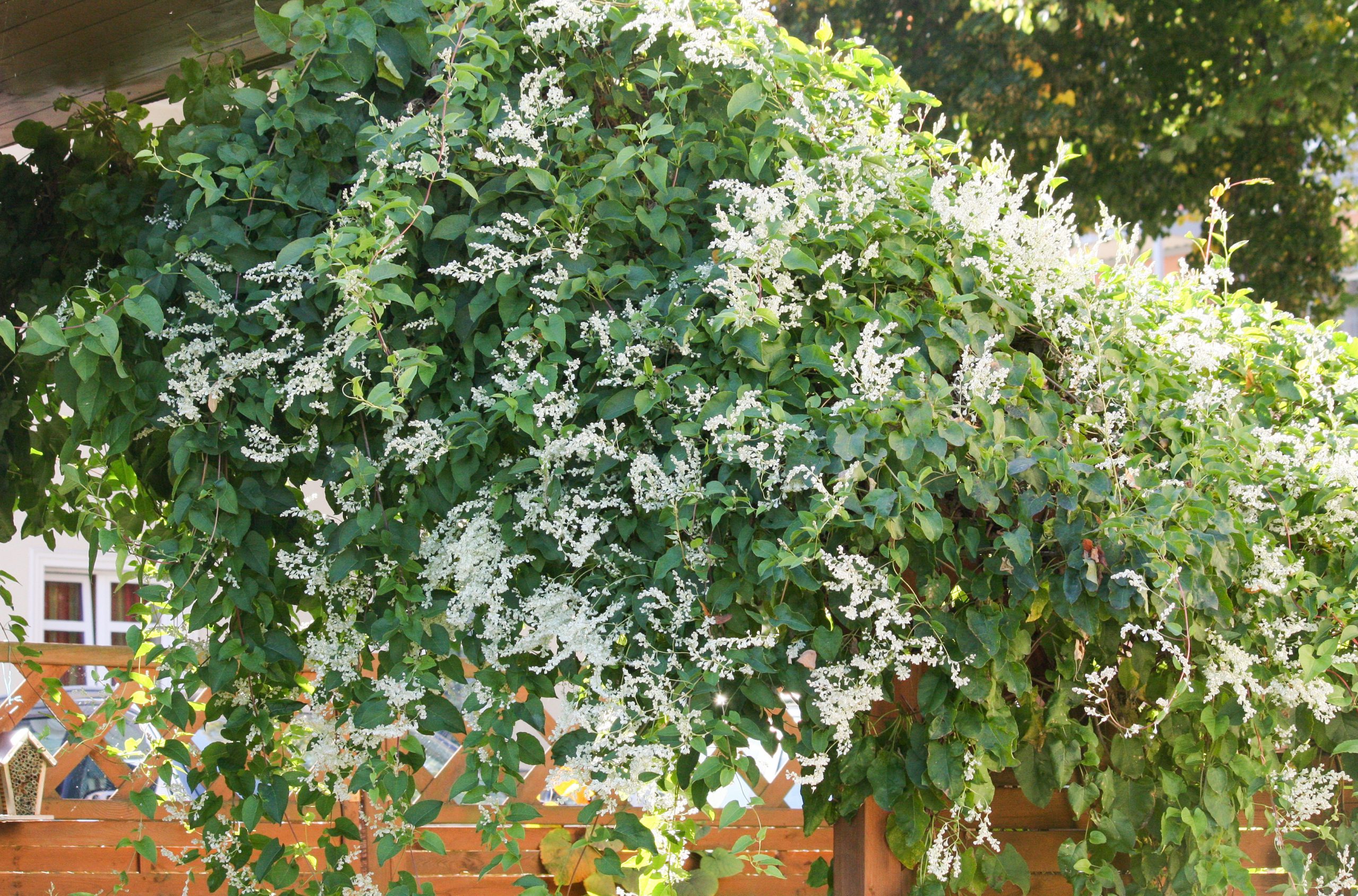
Russian Vine (Fallopia baldschuanica) doesn’t spread via rhizomes like Japanese Knotweed, but it does have cream-white panicles similar to Japanese knotweed’s. Photo by Maja Dumat licensed under licensed under CC BY 2.0
Commonly known by gardeners as ‘mile-a-minute’, Russian vine is a fast-growing relative to Japanese knotweed [20] which also shares some physical traits which often lead to its misidentification. Whilst its flowering structure and masses of green leaves are arguably a red herring, the key difference here is that the vine is a climbing plant that relies on other structures, be it plants or buildings, to grow upwards, as opposed to Japanese knotweed which supports itself.
Hedge Bindweed (Calystegia sepium)
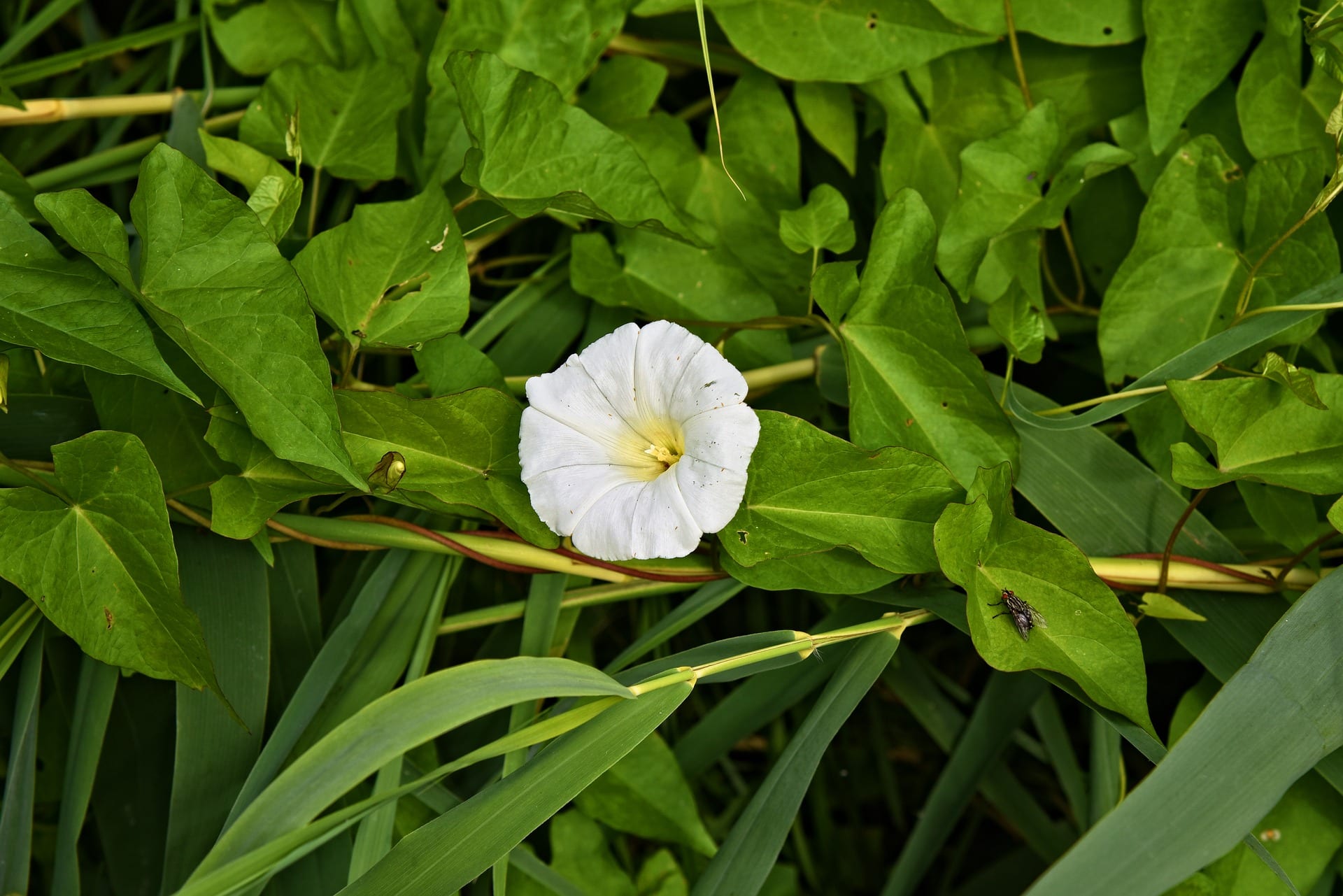
Hedge Bindweed (Calystegia sepium)
Bindweed is often incorrectly identified as Japanese Knotweed. This is because Bindweed has leaves similar to Japanese knotweed’s heart-shaped pointed tipped leaves [21] that also grow in an alternate pattern along the stem just like Japanese Knotweed. Similar to Japanese Knotweed, bindweed can grow to cover a large area very quickly and start to appear in spring. A key difference between Japanese Knotweed and bindweed is bindweed’s large pink and white trumpet flowers which start growing in early summer, these are clearly different to knotweed’s small, creamy white flowers.
Dogwood (Cornus)
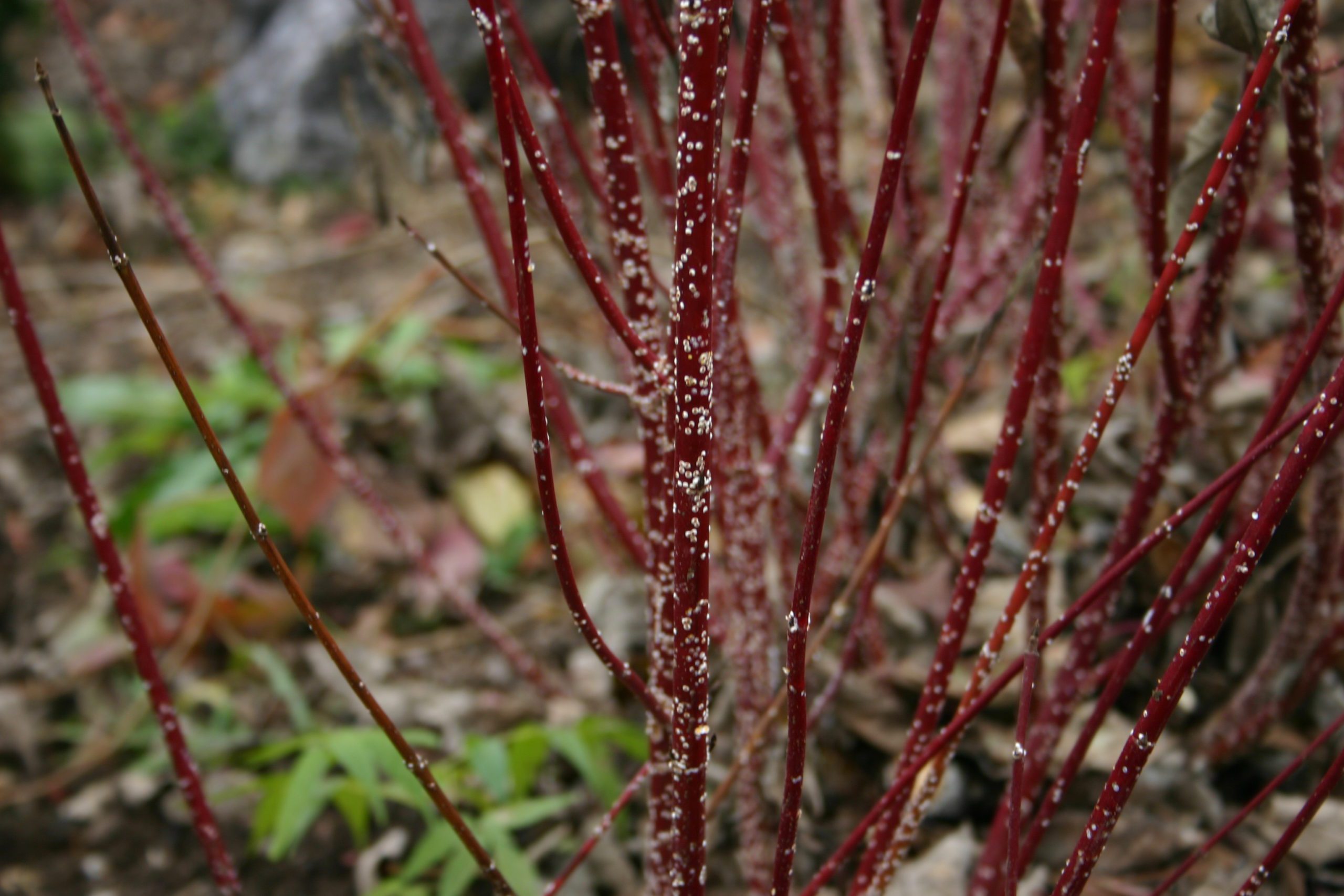
Red-stemmed Dogwood (Cornus) has stems similarly coloured and shaped to Japanese knotweed. Photo by Kerja sendiri licensed under CC-BY-SA-3. 0
Japanese knotweed is technically a herbaceous perennial plant. The plant is often mistaken for a shrub due to the large amounts of foliage it produces. Common shrubs such as lilac, poplar and dogwood (above) also feature similarly-shaped leaves, which can lead to misidentifications. This woody shrub is often mistaken for Japanese knotweed because of the similarity in its leaf shape and colour. During spring these bright leaves are accompanied with creamy white flowers which also make it easy to confuse with Fallopia Japonica. The uninitiated may also be drawn to its bright red woody stems that grow throughout winter [22]. Being a shrub, this plant can also grow readily and may appear to be invasive, when in fact it can easily be trimmed back. The key difference between this plant and knotweed is its woody stems which can be stripped down, as opposed to the hollow Japanese knotweed canes that can be snapped.
Heart-leaved houttuynia (Houttuynia cordata)
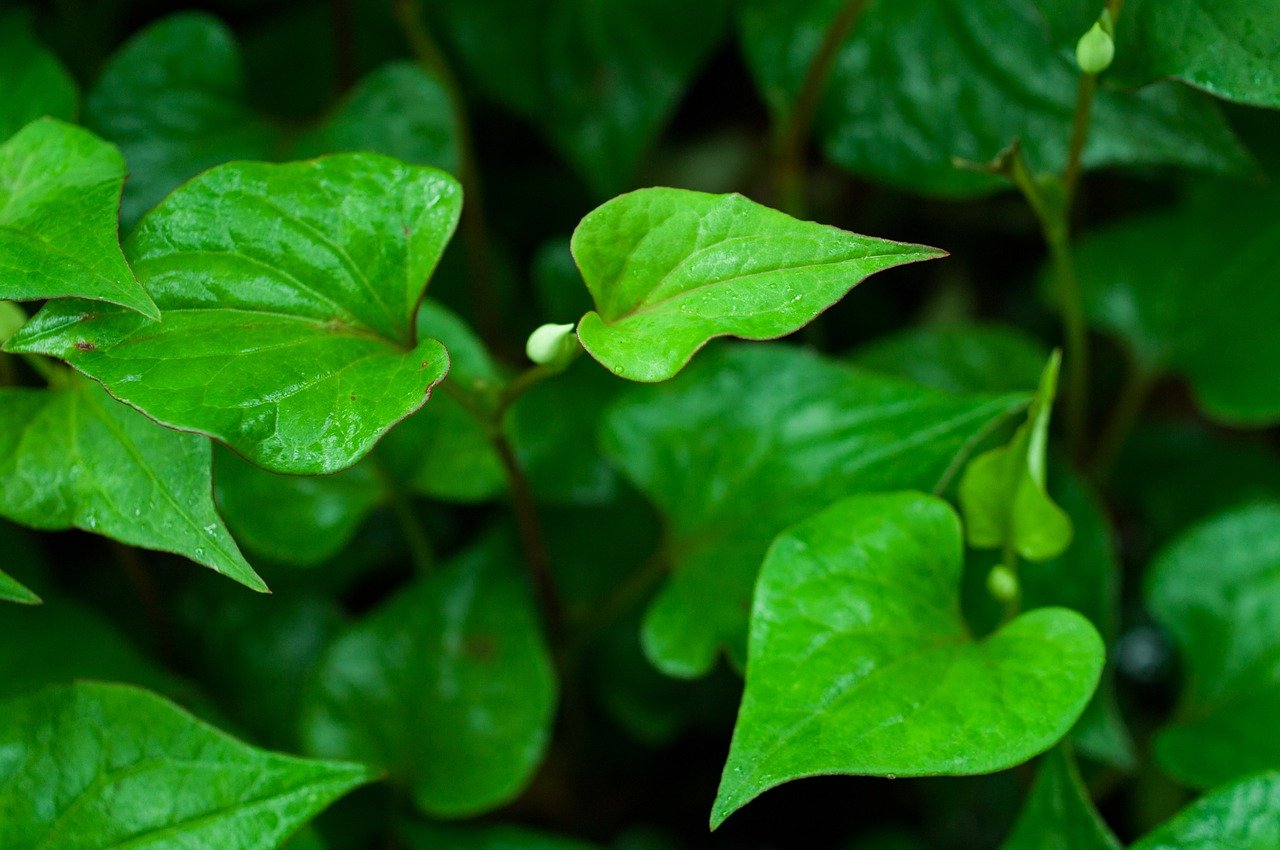
Heart-leaved houttuynia (Houttuynia cordata) heart shaped leaves are very similar to Japanese knotweed
This herbaceous perennial is rhizomatous, just like Japanese knotweed, and also features heart-shaped leaves which may cause alarm bells to ring. Despite these initial similarities, however, there are some key differentiators which make it easy to distinguish. Heart-leaved houttuynia produces tiny yellow flowers in spikes [23], as opposed to the large spikes of creamy-white flowers of Japanese knotweed. The plant also grows to a maximum height of 30cm, making it much smaller in stature than even the dwarf variety of Japanese knotweed.
Red Bistort (Persicaria amplexicaulis)
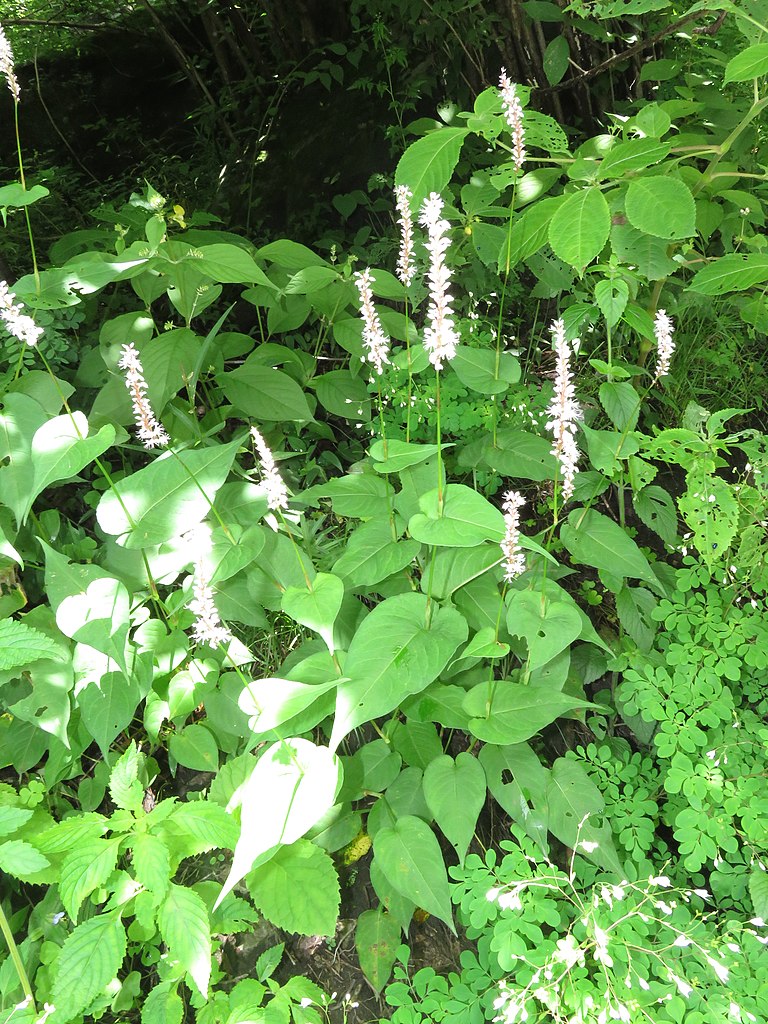
Red Bistort or Himalayan Fleece blooms white clustered panicles that are almost identical to Japanese knotweed flowers
Also known as Himalayan fleece, Red Bistort is native to China, Pakistan and the Himalayas. Another herbaceous perennial, this plant is a close relative of Japanese knotweed and grows to a maximum height of 1.5 metres. The flowers grow in similar spikes, however they are typically white or pink in colour, as opposed to cream [24]. The stems are hollow, just like Japanese knotweed and leaves are arranged alternately along the stems as well. Red bistort’s stems are usually much thinner, typically less than 1cm in diameter.
Himalayan Balsam (Impatiens glandulifera)
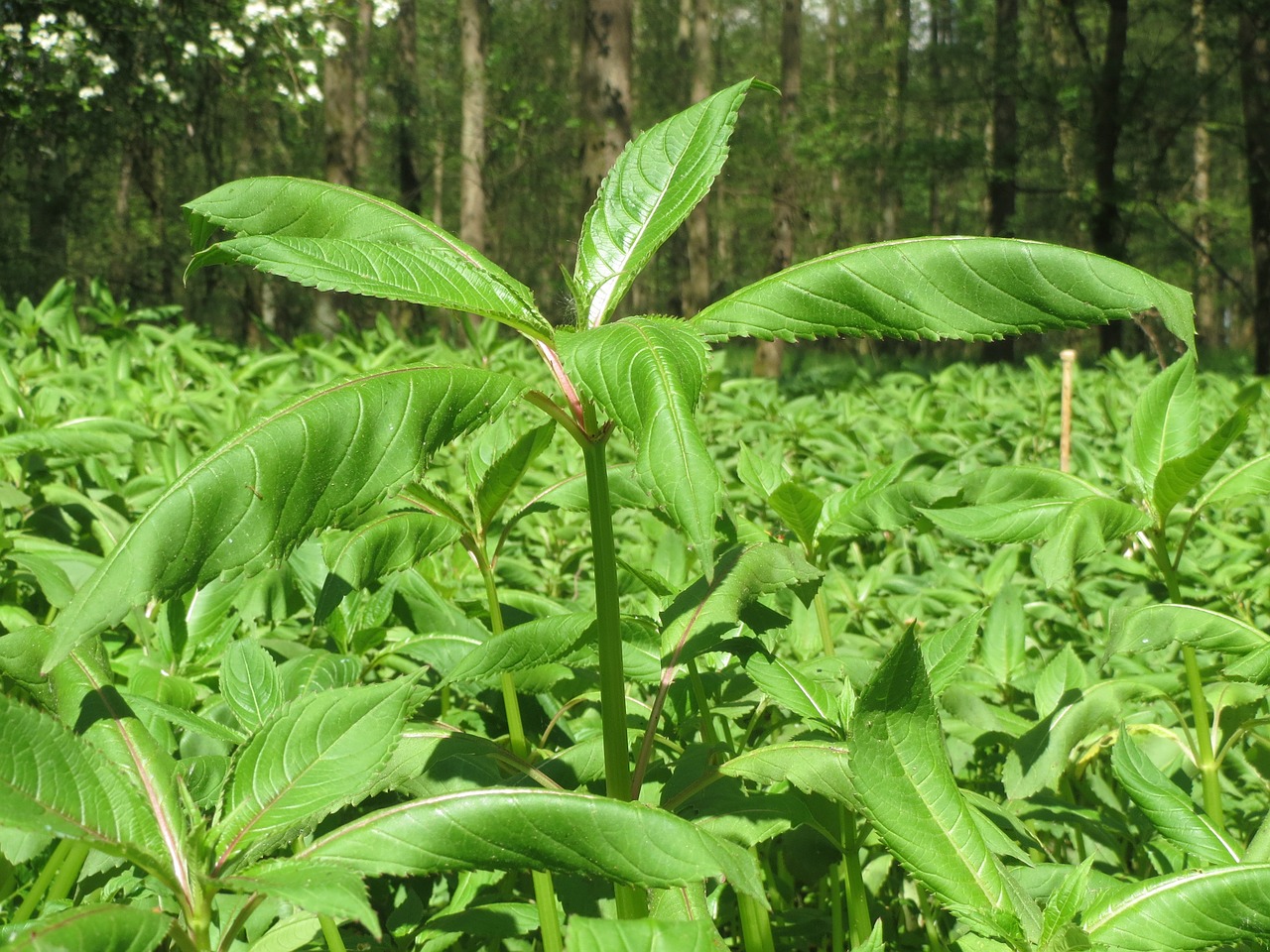
Himalayan Balsam (Impatiens glandulifera)
This invasive non-native plant grows throughout the year and can reach a height of 2.5 metres, reaching a similar height to Japanese knotweed. The stems are also hollow with leaves arranged in a similar alternate fashion. The leaves are a key differentiator, with Himalayan Balsam’s being much long and thinner than Japanese knotweed’s, with each leaf also featuring a pink mid rib. This plant can often be found growing near Japanese knotweed on watercourses [25], but spreads via seed dispersal as opposed to rhizome translocation.
Broadleaved Dock (Rumex obtusifolius)
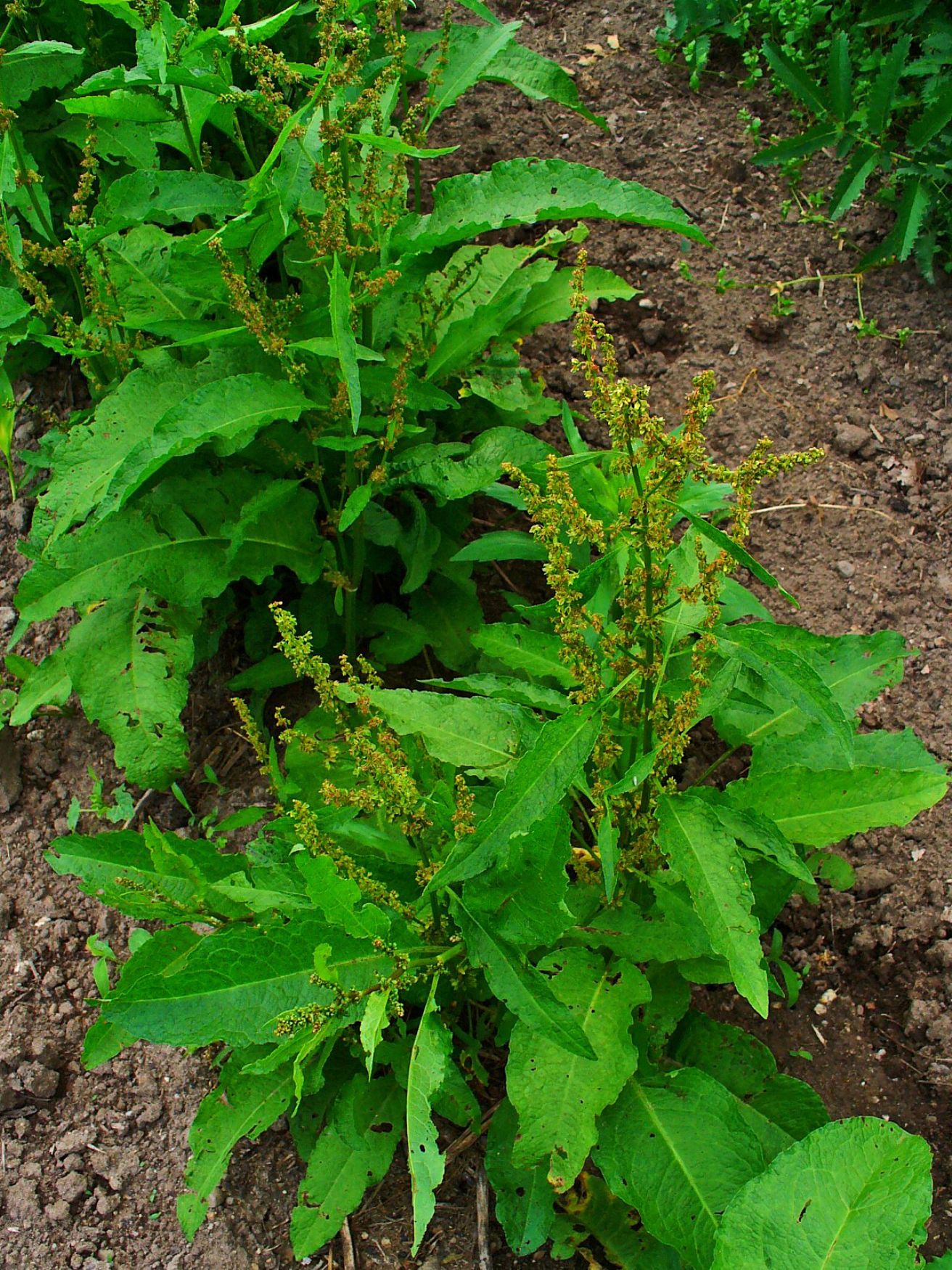
Broadleaved Dock (Rumex obtusifolius) shares similar sized leaves and panicles to Japanese knotweed
More commonly known as dock leaf, this plant’s most obvious similarity with knotweed is its titular leaf which is broad and green, however the physical similarities they share ends there. Once fully grown, the leaves themselves are much larger than Japanese knotweed and the plant itself is shorter in stature than knotweed, growing up to 1 metre tall. Although leaves are arranged alternately along stems, they will tend to form in tighter knit rosettes closer to the ground [26], as opposed to the larger bushy formations that Japanese knotweed develops. Stems, whilst being similarly hollow, contain a foamy-pith, and often resemble the Japanese knotweed as it dies back in winter.
Bamboo

Bamboo is commonly mistaken for Japanese knotweed due to their similar hollow stems
Bamboos is one of the fastest-growing plants in the world [27], so it’s unsurprising that it’s often confused with the similarly speedy Japanese knotweed, especially when you consider the likeness between the way the plants grow. Like Japanese knotweed, bamboo grows in nodes from difficult to eradicate rhizomes. At closer inspection there are some key differences: although shoots look similar, Japanese knotweed will snap when bent, whereas bamboo will not yield easily. The leaves are also very different, growing up to 50cm long, as opposed to Japanese knotweed’s smaller heart-shaped leaves.
Himalayan Honeysuckle (Leycesteria formosa)
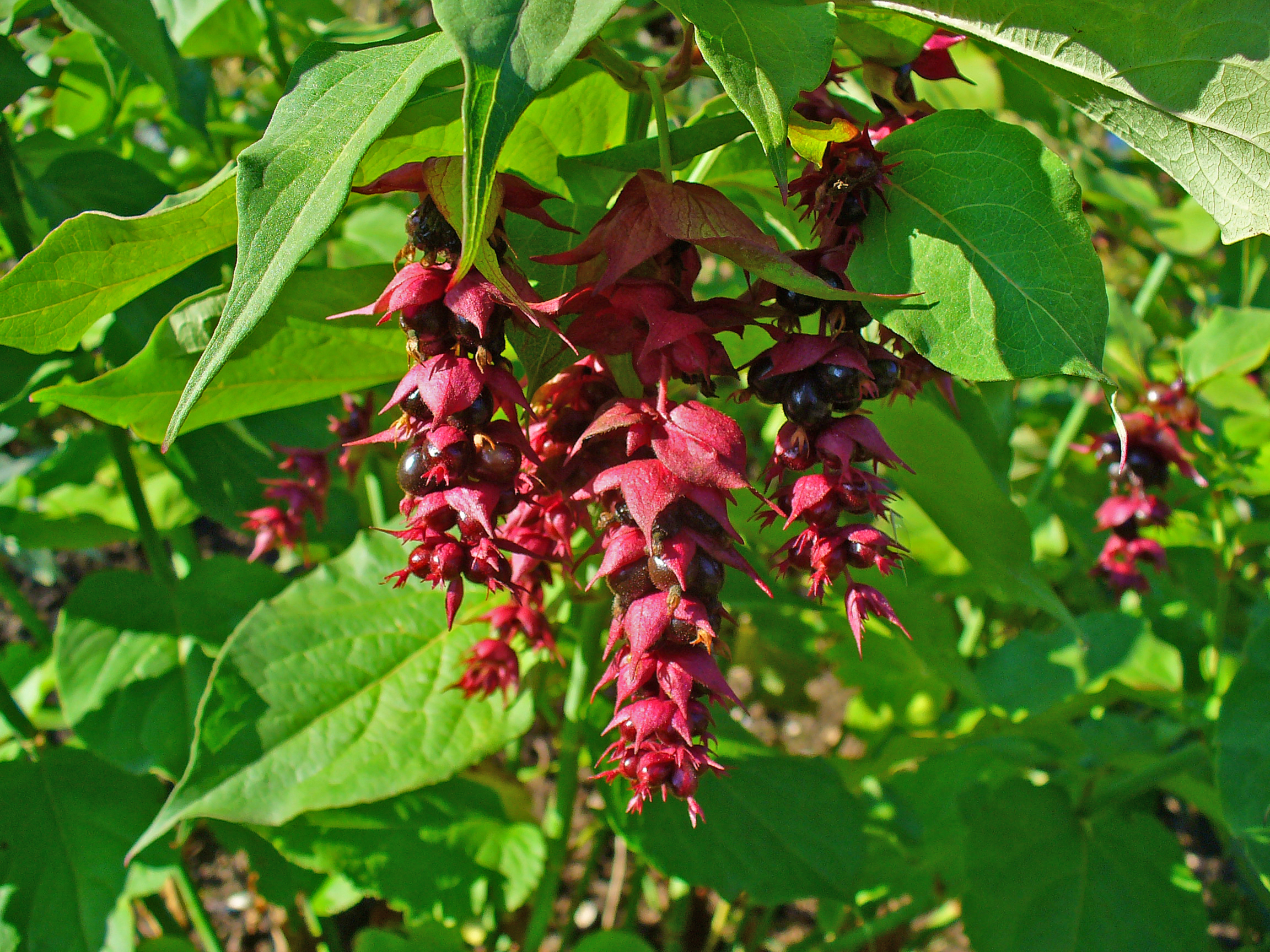
Himalayan Honeysuckle (Leycesteria formosa). Image by H. Zell licensed under CC BY-SA 3.0
This plant is considered an invasive plant in Australia and New Zealand, whilst being native to the Himalayas and China. It has bamboo-like stems that can be easily snapped, which often leads to it being mistaken for Japanese knotweed. Besides the stems, though, there are many differentiators including the formation of leaves opposite to another along the stem (as opposed to alternating) and a lack of purple speckling along the stems. The flowers form in pendulous racemes, as opposed to spikes, and also feature deep purple berries [28] which makes it much easier to distinguish from Japanese knotweed.
Horsetail (Equisetum arvense)
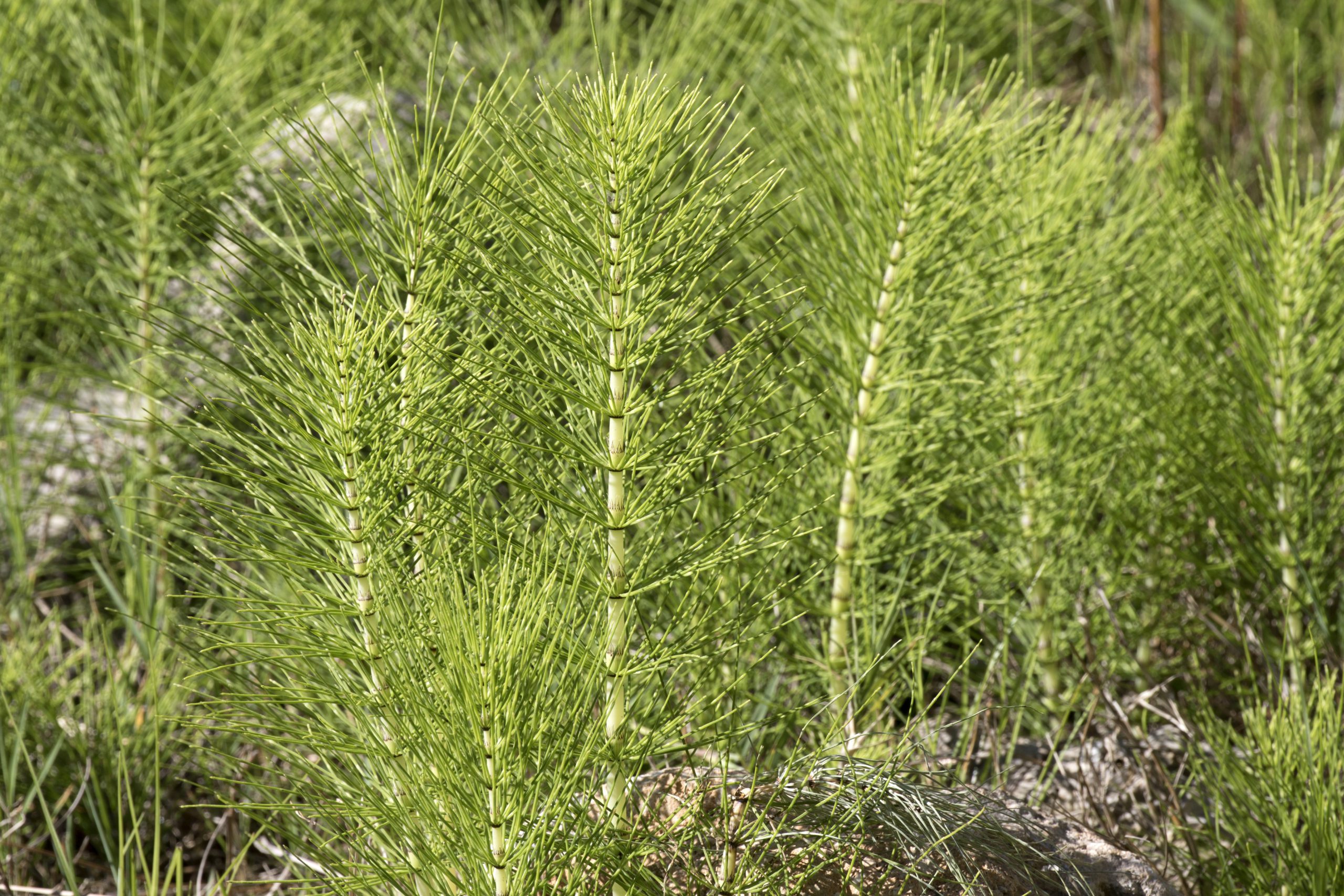
Horsetail (Equisetum arvense). Photo by Zeynel Cebeci licensed under CC BY-SA 4.0
Horsetail will only be mistaken for Japanese knotweed when it is in its infancy. Its shoots can grow at a fast pace in spring and may also appear in a large quantity. These strobili die back after they’ve released their spores, however, and are soon replaced by green stems that are segmented into nodes, similar to Japanese knotweed. As soon as Horsetail’s signature brush-like growth forms it becomes apparent that this plant is very different to Japanese knotweed, however it’s still an invasive plant that should be dealt with [29].
Buckwheat (Fagopyrum esculentum)
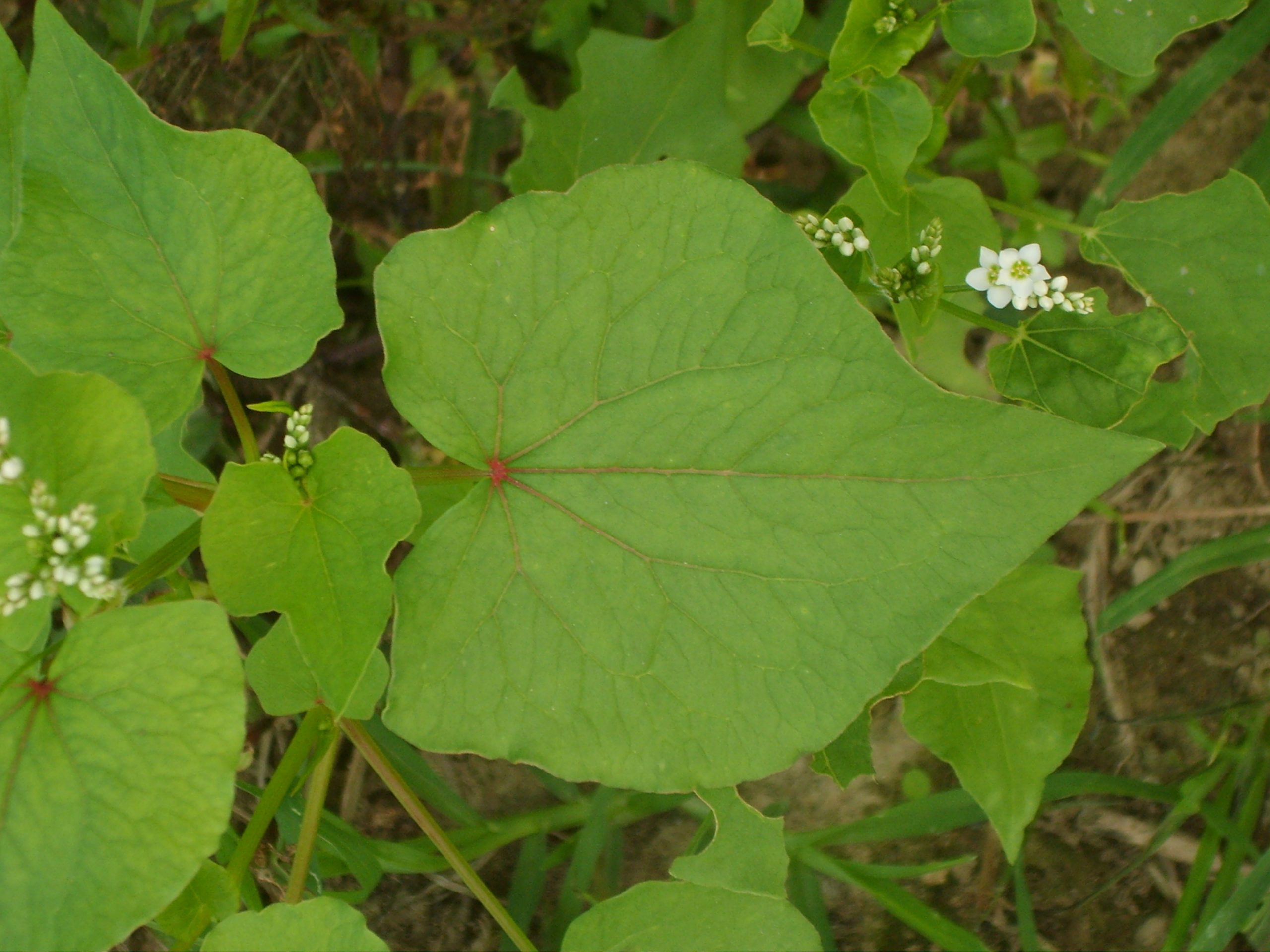
Buckwheat (Fagopyrum esculentum) heart shaped pointed leaves are almost identical to Japanese knotweed leaves
Despite its name, Buckwheat is not wheat or grass. The plant is closely related to plants, such as knotweed [30], which explains why it is sometimes confused for it. Buckwheat closely resembles its relative when first shooting. Its stems develop marked nodes and its leaves are also arranged alternately along its stems. The leaves are, however, a much different shape to knotweed, often angular and thin, with the base of the leaf clasped around the stems. The flowers are larger and develop as pink or white clusters at the end of stems.
Free Japanese Knotweed identification service
Upload your photoDo you need help identifying Japanese Knotweed?
Getting a positive identification of Japanese knotweed can be difficult if you’re unaware of the seasonal changes the plant goes through, or the numerous copycats that it can be mistaken for. Japanese knotweed can cause damage to property and the environment, so it’s important to be vigilant and pay take note of any unfamiliar plants growing on your land.
If you have any plant matter on your land that resembles these descriptions or images then it’s worth taking photos and sending them to us using the form on the right. We could help you recover the costs of treatment, especially if you’ve bought a property with Japanese knotweed or if it has entered your property from a neighbouring property.
Write us a message, chat with us, or give us a call on 0151 668 0561.
References
[2] Japanese Knotweed Profile – RHS
[3] Japanese Knotweed Profile – CABI Invasive Species Compendium
[4] Giant Knotweed Profile – Plantlife
[5] Fallopia x bohemica Profile – CABI Invasive Species Compendium
[6] How is it spread? – Cornwall Council
[7] The Japanese knotweed invasion viewed as a vast unintentional hybridisation experiment – Nature
[9] PCA Guidance Note on Japanese Knotweed Control: Guidance Notes for Herbicide Treatment
[10] Identification – Department of Genetics and Genome Biology, Leicester University
[11] Giant Knotweed and Hybrids – CABI Invasive Species Compendium
[12] What is Japanese knotweed? – CABI Invasive Species Compendium
[13] Knotty but nice for bees – Honey Bee Suite
[14] How to deal with problems associated with Japanese knotweed (Fallopia Japonica) – PCA
[15] Japanese Knotweed Species Description – NNSS
[16] Giant knotweed identification and control – King County Gov
[19] Fallopia x conollyana The Railway-yard Knotweed – Biology Department, University of Leicester
[20] How to Grow Fallopia Russian Vine ‘Mile A Minute Plant’ – Sunday Gardener
[22] Cornus Profile – RHS
[23] Houttuynia cordata Profile – RHS
[24] Persicaria amplexicaulis ‘Firetail’ – RHS
[25] Himalayan Balsam Profile – RHS
[26] Docks Profile – RHS
[27] The Book of Bamboo
[28] Himalayan Honeysuckle Profile – RHS
Resources
University of Leicester’s Japanese Knotweed Research
Government Guidance on Identifying and Preventing Spread of Japanese Knotweed
